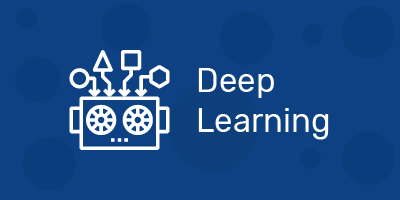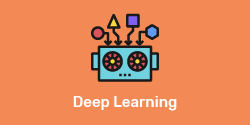-
Deep learning is a machine learning technique that teaches computers to do what comes naturally to humans: learn by example. Deep learning is a key technology behind driverless cars, enabling them to recognize a stop sign, or to distinguish a pedestrian from a lamppost. It is the key to voice control in consumer devices like phones, tablets, TVs, and hands-free speakers. Deep learning is getting lots of attention lately and for good reason. It’s achieving results that were not possible before.
In deep learning, a computer model learns to perform classification tasks directly from images, text, or sound. Deep learning models can achieve state-of-the-art accuracy, sometimes exceeding human-level performance. Models are trained by using a large set of labeled data and neural network architectures that contain many layers.
- WHAT YOU WILL LEARN
-
Key Learnings :
- Understand the concepts, its main functions, operations and the execution pipeline
- Implement deep learning algorithms, understand neural networks and traverse the layers of data abstraction which will empower you to understand data like never before
- Master and comprehend advanced topics such as convolutional neural networks, recurrent neural networks, training deep networks and high-level interfaces
- Build deep learning models in TensorFlow and interpret the results
- Understand the language and fundamental concepts of artificial neural networks
- Troubleshoot and improve deep learning models
- Build your own deep learning project
- Differentiate between machine learning, deep learning and artificial intelligence
- COURSE CURRICULUM
-
Topics Covered During Classroom :
Neural Networks
INTRODUCTION TO NEURAL NETWORKS
➔ In this lesson, you will learn solid foundations on deep learning and neural networks. You’ll also implement gradient descent and backpropagation in Python.
IMPLEMENTING GRADIENT DESCENT
➔ Mat and Luis will introduce you to a different error function and guide you through implementing gradient descent using NumPy matrix multiplication.
TRAINING NEURAL NETWORKS
➔ Now that you know what neural networks are, in this lesson, you will learn several techniques to improve their training. Learn how to prevent overfitting of training data and best practices for minimizing the error of a network. SENTIMENT ANALYSIS
➔ In this lesson, Andrew Trask, the author of Grokking Deep Learning, will show you how to define and train a neural network for sentiment analysis (identifying and categorizing opinions expressed in the text).
DEEP LEARNING WITH PyTorch
➔ Learn how to use PyTorch for building and testing deep learning models.
Convolutional Neural Networks
Lesson Title Learning Outcomes CLOUD COMPUTING ➔ Take advantage of Amazon’s GPUs to train your neural network faster. In this lesson, you’ll set up an instance on AWS and train a neural network on a GPU.
CONVOLUTIONAL NEURAL NETWORK
➔ Alexis and Cezanne explain how Convolutional Neural Networks can be used to identify patterns in images and how they help us dramatically improve performance in image classification tasks.
CNN’s IN PyTorch
➔ In this lesson, you’ll walk through an example Convolutional Neural Network (CNN) in PyTorch. You’ll study the line-by-line breakdown of the code and can download the code and run it yourself.
WEIGHT INITIALIZATION
➔ In this lesson, you’ll learn how to find good initial weights for a neural network. Having good initial weights often allows a neural network to arrive at an optimal solution, faster than without initialization.
AUTOENCODERS
➔ Autoencoders are neural networks used for data compression, image denoising, and dimensionality reduction. Here, you’ll build autoencoders using PyTorch. TRANSFER LEARNING IN PyTorch
➔ Most people don’t train their own networks on massive datasets. In this lesson, you’ll learn how to finetune and use a pre-trained network and apply it to a new task using transfer learning.
Recurrent Neural Networks
RECURRENT NEURAL NETWORKS
➔ Ortal will introduce Recurrent Neural Networks (RNNs), which are machine learning models that are able to recognize and act on sequences of inputs.
LONG SHORT-TERM MEMORY NETWORK
➔ Luis explains Long Short-Term Memory Networks (LSTM), and similar architectures that form a memory about a sequence of inputs, over time.
IMPLEMENTATION OF RNN & LSTM
➔ Train recurrent neural networks to generate new characters, words, and bodies of text. HYPERPARAMETERS
➔ In this lesson, we’ll look at a number of different hyperparameters that are important for our deep learning work, such as learning rates. We’ll discuss starting values and intuitions for tuning each hyperparameter. EMBEDDINGS & WORD2VEC
➔ In this lesson, you’ll learn about embeddings in neural networks by implementing a word2vec model that converts words into a representative vector of numerical values.
SENTIMENT PREDICTION RNN
➔ In this lesson, you’ll learn to implement a recurrent neural network for predicting sentiment. This is intended to give you more experience building RNNs.
Generative Adversarial Networks
Lesson Learning Outcomes
GENERATIVE ADVERSARIAL NETWORK
➔ Ian Goodfellow, the inventor of GANs, introduces you to these exciting models. You’ll also implement your own GAN on a simple dataset.
DEEP CONVOLUTIONAL GANs
➔ Implement a Deep Convolutional GAN to generate complex, color images of house numbers. PIX2PIX & CYCLEGAN
➔ Jun-Yan Zhu and Cezanne lead you through a CycleGAN formulation that can learn from unlabeled sets of images.
Model Deployment
Lesson Title Learning Outcomes
INTRODUCTION TO DEPLOYMENT
➔ Learn where cloud deployment is used in industry and about various methods for deployment (websites, apps, etc.). Become familiar with cloud deployment terminology. DEPLOY A MODEL
➔ Deploy a model using Amazon SageMaker and learn to apply built-in algorithms, like XGBoost, to a variety of tasks.
CUSTOM MODELS & WEB HOSTING
➔ In this lesson, you’ll train and deploy your own PyTorch model. Then, see how to define a gateway using SageMaker to allow for outside-access to your model. See how your model responds to user input.
MODEL MONITORING
➔ In this lesson, learn how to interpret log messages and monitor the behavior of your model over time. See how to implement an A/B test, in SageMaker, to evaluate the performance of two different models.
UPDATING A MODEL
➔ Developing a machine learning model is an iterative process. Learn how to look at indicators like data distribution to see if you should update a model.
Training Duration & Pricing:
For Individuals
Duration: 1.5 Months and we also offer 2 Months Offline Support
Mode: Classroom & Online
Course Fees: Call us at +91-9900001329
For Corporate Training
The Mobignosis Corporate Training Program is designed for organisations who require practical upskilling for their employees to gain knowledge on the current trending technologies
CERTIFICATION

Candidates receive Mobignosis course completion certificate upon successful completion of course
FAQs
The course is an instructor led classroom/online coaching session
The instructors are industry experts (AI Professionals) who consult with leaders in technology services like SAP, Capgemini, Cisco and many others
As a team of practicing AI professionals, we use the leading edge methodologies in our consulting work and have used the same methodologies to develop the Deep Learning course content for classroom coaching. So, you are exposed to the most up to date quality course contents
The Deep Learning Training program includes 2 months free technical support post training, the participants can repeat the session free of cost, For any additional assistance we are just a phone call away


